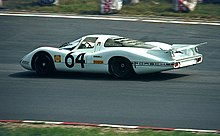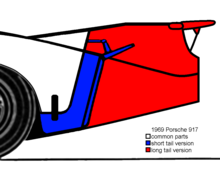Short and long tail (racing car construction)
The short and long tail are body design variants of racing cars that were used for special racetracks .
In the 1960s, racing cars with different body designs were produced in order to optimally adapt them to the conditions specific to the racetrack. Aerodynamics in particular became increasingly important in racing.
A particularly aerodynamically designed body was an advantage on racetracks that allowed particularly high average lap speeds due to the long, straight course. A well-known example are the Le Mans 24-hour races . For these races, the long-tail body was used by some manufacturers, such as Porsche . The racing cars with long tail had less air resistance than the cars with short tail and reached higher top speeds. In practice, the speed difference was up to 20 km / h.
The disadvantage of the long tail compared to the short tail is the greater instability, especially when cornering. For this reason, racing cars with a short tail were mostly used in races with a particularly high number of corners and few straights.
Well-known racing cars, of which short and long tail versions were built, are the Porsche 908 and Porsche 917 . As an example, here are the maximum speed figures for the Porsche 917 from 1969.
- As long-tail version: approx. 340 km / h
- As a short tail version: approx. 320 km / h


